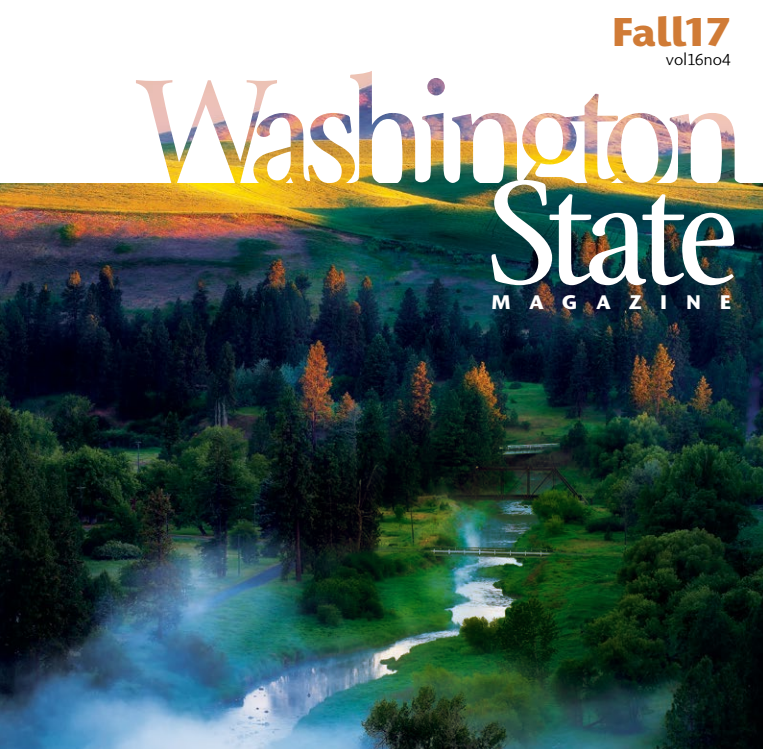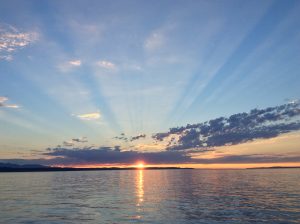 High in the Cascade and Olympic Mountain snowfields, pristine rivulets trickle into brooks that descend through forest, farmland, and town. Streams merge into rivers and sweep through cities until finally breaking into Puget Sound and the marine waters of the Pacific.
High in the Cascade and Olympic Mountain snowfields, pristine rivulets trickle into brooks that descend through forest, farmland, and town. Streams merge into rivers and sweep through cities until finally breaking into Puget Sound and the marine waters of the Pacific.
There, in the southern arm of the Salish Sea, the waters mingle in a fertile estuary teeming with biodiversity.
“Looking out at the waters of Puget Sound, you see the sunset, the beautiful mountains, and people think, ‘Everything is good, we’ve got the orca.’ But we have invisible problems,” says Chrys Bertolotto, natural resource programs manager at the Washington State University Snohomish County Extension office in Everett.
Indeed, the region’s rich natural resources have attracted a booming population complete with homes, schools, industry, and the inevitable waste products they generate. Much of it, unfortunately, ends up in the Sound. At least 63,000 pounds of toxic chemicals each day.
Before the passage of the 1972 Clean Water Act, unfiltered wastewater from smelters, pulp mills, and sewage treatment plants was freely discharged into the Duwamish River and other Sound waterways. Regulations and permits have successfully decreased industrial pollution but a dozen or so Superfund sites remain in remediation.
Today, it is estimated that 75 percent of Sound contamination is unwittingly produced by citizens. Hidden residues from everyday activities are carried by stormwater runoff over miles of paved highways, paths, and parking lots that have essentially become an extensive new system of “rivers.”
With every rainfall, a toxic slew of animal manure, roofing materials, vehicle debris, home and garden chemicals, and sewage from failing septic tanks is washed down those conduits into the Sound.
The estuary also suffers from a slow rate of water exchange, allowing chemicals and bacteria to linger in bays and inlets. It all adds up to an ailing ecosystem, with negative effects on plants, wildlife, and humans alike. Rivers and streams once thick with Coho and Chinook salmon now see a fraction returning to spawn. Bacterial contamination of shellfish beds and swimming beaches is common. Water supplies are vulnerable.
In 2007, an alliance of concerned citizens and organizations formed a state agency called the Puget Sound Partnership whose goal is to restore the Sound to health by 2020 and safeguard it for future generations.
Their progress can be tracked by a “Vital Signs” wheel that colorfully highlights six major areas of concern, each with specific indicators of the Sound’s  health such as eelgrass habitat and economic vitality.
health such as eelgrass habitat and economic vitality.
It’s an enormous undertaking that relies heavily on regional and local efforts. Hundreds of state, federal, municipal, tribal, and nonprofit organizations work together to keep recovery on track. Among those participating is WSU Extension.
From Puyallup to Bremerton, Port Townsend to Everett, WSU Extension and research centers are immersed in Puget Sound revitalization through a combination of investigation, stewardship, and educational outreach programs.
Bertolotto, who directs the Snohomish County Beach Watchers program, is just one of many Extension agents who use the latest scientific discoveries to design locally relevant community projects and train volunteers to become citizen scientists.
It may be surprising that WSU, whose original campus is 300 miles away in dryland farming country, can be a partner in marine and freshwater recovery efforts.
But as Bertolotto says, “We’re a well-kept secret.”
On a sunny day at the Puyallup Research and Extension Center, tulips and even the grass seem jubilant as John Stark walks out of the tidy brick admin building en route to his outdoor laboratory.
The New York native and WSU professor of ecotoxicology is one of the original members of the Puget Sound Partnership Science Panel and helped design the Vital Signs wheel.
“Every slot on the wheel is very important,” he says. “We try to cover all major issues affecting quality of life in the Sound, from scientific to social impacts.”
The panel advises Partnership directors on the best ways to protect the Sound while improving ecosystem health. The panel was key in pinpointing stormwater as today’s biggest source of contamination.
Continue reading in Washington State Magazine (pg. 22 print // pg. 13 PDF)
Originally written by Rebecca Phillips